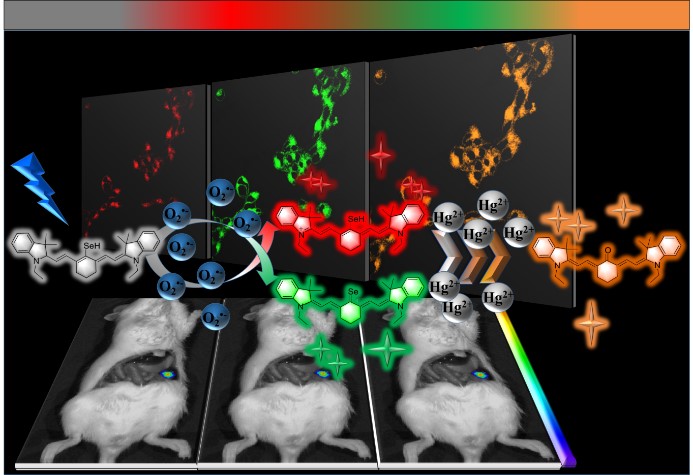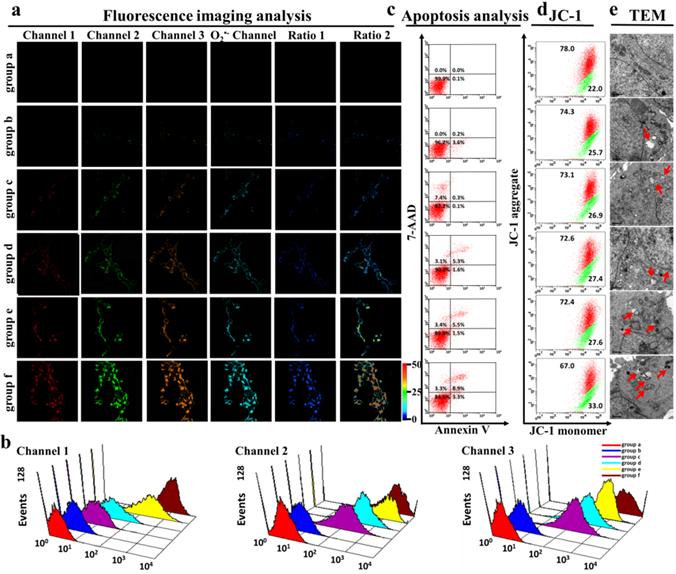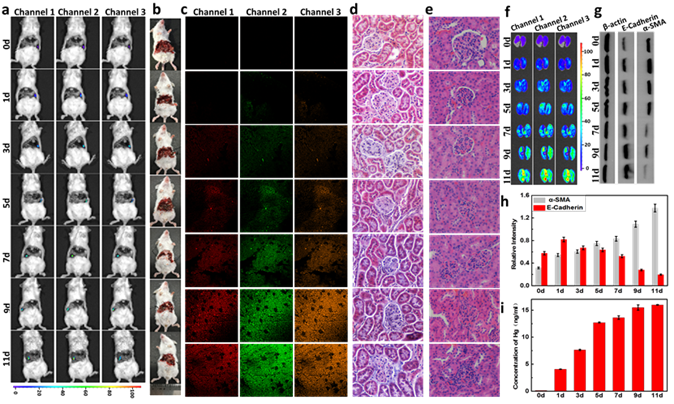博文
Detection O2•- and Hg2+ via three-channel fluorescent probe
|
Associated detection of O2•- and Hg2+ under chronic mercury exposure in cells and mice models via a three-channel fluorescent probe
Yue Wang,ad【王悦】 Min Gao,ad�【高敏】� Qingguo Chen,c�【陈庆国】�Fabiao Yu,ac* 【于法标】Guibin Jiang b�【江桂斌】� and Lingxin Chenac*【陈令新】
a CAS Key Laboratory of Coastal Environmental Processes and Ecological Remediation, Research Center for Coastal Environmental Engineering and Technology, Yantai Institute of Coastal Zone Research, Chinese Academy of Sciences, Yantai 264003, China.
b State Key Laboratory of Environmental Chemistry and Ecotoxicology, Research Center for Eco-Environmental Sciences, Chinese Academy of Sciences, Beijing 100085, China.
c School of Marine Science and Technology, Zhejiang Ocean University, Zhoushan 316022, China.
d University of Chinese Academy of Sciences, Beijing 100049, China.
�ABSTRACT: As a cytotoxic heavy metal ion, Hg2+ induces severe oxidative stress and further results in physiological dysfunction. Although mercury poisoning can be treated with many drugs such as sodium selenite, the therapeutic effect is relatively poor. And it seems that the damage to human health continues. However, the interpretation for the pathogenesis has not been clarified yet. We suppose that the reason is attributed to Hg2+-caused intracellular oxidative stress. To confirm our hypothesis, we strive to design a three-channel ratio fluorescent probe HCy-SeH for O2•- and Hg2+ combined-detection. O2•- is a vital precursor for other ROS, which is involved in many physiological and pathological processes. However, until now there is no efficient chemical tool for O2•- and Hg2+ combined-detection in cells and in vivo. Fluorescence response of our probe initiates by hydrogen abstraction reaction from the hydrocyanine fluorophore moiety. Once oxidized by O2•-, HCy-SeH recovers its π-conjugated system back to a heptamethine cyanine derivative Cy-SeH. Cy-SeH coexists with its conjugate base Cy=Se. One emits red fluorescence and the other one emits green fluorescence. The response unit -SeH can trap Hg2+ via a Se-Hg antagonism reaction to afford an orange-emitting final product Keto-Cy. The probe offers high selectivity and sensitivity towards O2•- and Hg2+. When applied for O2•- and Hg2+ detection in HEK 293 cells, the imaging results indicate that our probe can combined-response O2•- and Hg2+ in real-time and in situ. Flow cytometry analysis is consisted well with the results from fluorescence imaging. When applied to image O2•- and Hg2+ in mice models, we find that Hg2+ dominantly accumulates in kidney and induces burst of O2•-. We confirm that chronic mercurialism can cause severe oxidative damage and renal fibrosis. HCy-SeH further provides a new information that even intracellular Hg2+ has been antagonized, the outbreak of O2•- caused by mercury poisoning still last.
�
�
�
Scheme 1. Molecular structure and the proposed mechanism for O2•- and Hg2+ associated-detection.
�
Figure 1. In situ detection of O2•- and Hg2+ in HEK 293 cells. (a) Fluorescence imaging of the probe for O2•− and Hg2+ detection by laser scanning confocal microscope. Channel 1 760 - 850 nm (λex = 635 nm), channel 2 λem = 540 - 585 nm (λex = 405 nm), channel 3 λem = 585 - 685 nm (λex = 488 nm), O2•- channel λem = 500 - 530 nm (λex = 488 nm), ratio 1: channel 3 vs channel 2, and ratio 2: channel 3 vs channel 1. (b) Fluorescence intensity analyzed by flow cytometry. (c) Apoptosis analysis by Annexin V / 7-AAD Apoptosis Detection Kit: viable cells (AnnexinV - / 7-AAD -), early apoptosis (AnnexinV + / 7-AAD -), late apoptosis (AnnexinV + / 7-AAD +), necrosis (AnnexinV - / 7-AAD +). (d)△Ψm analysis by JC-1. group a: The cells were incubated with 10 μM HCy-SeH for 10 min as control. group b: The cells were pretreated as described in group a, and then O2•- (10 μM) was added for 15 min. group c: Then cells in group c were pretreated as described in group b, and 10 μM Hg2+ was added for 15 min. group d: The cells in group d were pretreated as described in group a, then stimulated with 10 nM PMA for 20 min. group e: The cells in group e were manipulated as that in group d, then 10 μM Hg2+ was added for 15 min. group f: Cells were pretreated as described in group a, and then 10 μM Hg2+ were added for 30 min. group g: Cells were pretreated as described in group a, then 60 μM Hg2+ were added for 30 min. group h: The cells were pretreated with 30 μM sodium selenite for 60 min, then the cells were treated as described in group f.
�
�Figure 2. Detection of O2•- and Hg2+ in cells with different concentration of Hg2+ stimulation. (a) Laser scanning confocal microscope analysis. (b) Flow cytometry analysis. (c) Apoptosis analysis by Annexin V/7-AAD Apoptosis Detection Kit: viable cells (AnnexinV-/7-AAD-), early apoptosis (AnnexinV+/7-AAD-), late apoptosis (AnnexinV+/7-AAD+), necrosis (AnnexinV-/7-AAD+). (d) △Ψm analysis by JC-1. (e) TEM observation (Scale bars: 1 μm). Concentrations of the Hg2+: group a 0 μM; group b 2 μM; group c 4 μM; group d 6 μM; group e 8 μM; group f 10 μM.
� �
�
Figure 4. Detection of O2•- and Hg2+ in mice model of chronic mercurialism. (a) Fluorescence imaging of kidney in the mice of chronic mercurialism through orthotopic injection assay. (b) The details of the organ ligation were obtained from the camera. (c) Fluorescence imaging of the kidney sections. The tissue sections were stained with HCy-SeH (10 μM) for 10 min. (d) Masson’s trichrome stain of the kidney sections. (e) H&E staining of the kidney sections from normal and model mice. (f) Fluorescence imaging of the kidneys from the mice in (a). (g) Western blot analysis of α-SMA and E-cadherin. (h) The relative intensity analysis of α-SMA and E-cadherin by Image-J software. (i) Detection of Hg2+ in kidneys by ICP-MS.
� �
�
�
Figure 5. Detection of O2•- and Hg2+ in mice model. (a) Fluorescence imaging of kidneys through orthotopic injection assay. (b) The details of the organ ligation were obtained from the camera. (c) Fluorescence imaging of the kidney sections from normal and model mice. (d) Masson’s trichrome stain of the kidney sections from normal and model mice. (e) H&E staining of the kidney sections from the mice in (a). (f) Fluorescence imaging of the kidneys from the mice in (a). (g) Western blot analysis of α-SMA and E-cadherin. (h) The relative intensity analysis of α-SMA and E-cadherin by Image-J software.
�
Anal. Chem., Just Accepted Manuscript
DOI: 10.1021/acs.analchem.8b01442
Publication Date (Web): July 20, 2018
�https://pubs.acs.org/doi/10.1021/acs.analchem.8b01442�
https://blog.sciencenet.cn/blog-2438823-1126195.html
上一篇:Detection MOAB enzyme and its oxidative stress by NIR probe
下一篇:selenium-containing probe for sulfane sulfur under hypoxia
全部作者的其他最新博文
- • Triphenylamine-AIE Materials for Cancer Theranostics
- • Fluorescent Probe forRatiometric Monitoring of Peroxynitrite
- • Fluorescence Probe for Pathological Stages of Wound Healing
- • Macrophage M2 polarization to neurological damage
- • SERS-RCA biosensor for profiling dual miRNAs
- • a glutathione-activated near-infrared fluorescent probe